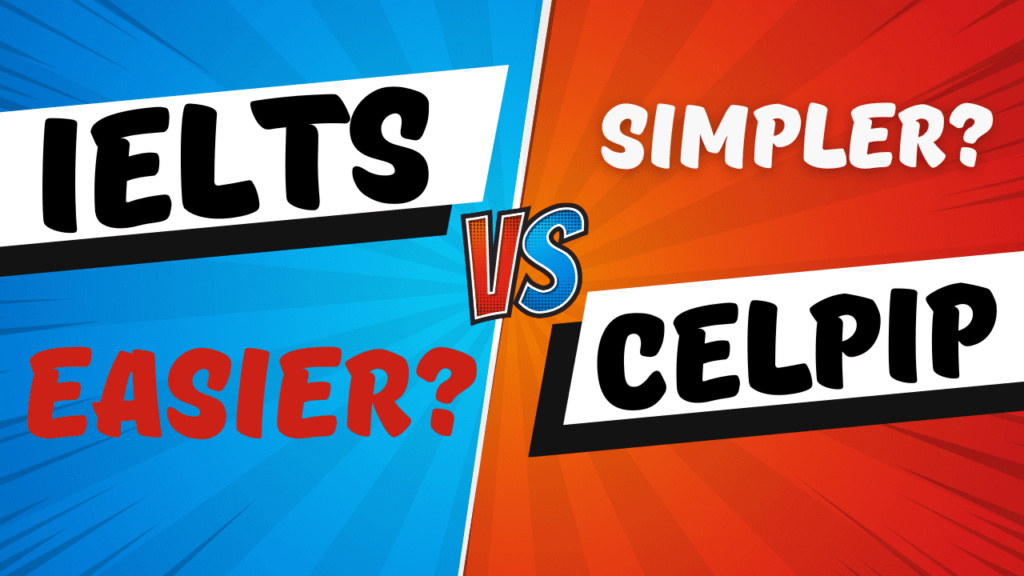An In-Depth Exploration of CELPIP VS IELTS: Unraveling the Ease Factor!
The CELPIP (Canadian English Language Proficiency Index Program) and IELTS (International English Language Testing System) exams have carved their niches as the benchmarks for English language proficiency assessment. The pivotal question that often surfaces is whether CELPIP is indeed easier than IELTS. This query transcends mere comparison; it requires an intricate examination of the modules, nuances, and intricacies that define both exams. In this comprehensive analysis, we’ll traverse the diverse facets of both CELPIP and IELTS, unraveling the aspects that contribute to their respective levels of difficulty.
Material Availability: CELPIP vs. IELTS
In the journey of exam preparation, resource availability becomes the cornerstone. IELTS, with its established prominence, offers an array of study materials, both free and paid, encompassing online platforms, preparatory courses, and official guides. This plethora of resources equips candidates with diverse strategies and insights. However, CELPIP, being relatively newer in comparison, presents a scarcity of comprehensive materials. Yet, amid this challenge, candidates can leverage specialized courses like the one from AIDS Education, which provide not only preparatory materials but also strategic approaches and mock tests to bridge the gap.
Reading and Listening Modules: Complexity and Format Differences
The reading and listening modules serve as pivotal arenas in gauging language proficiency. In CELPIP, a notable quirk arises—multiple-choice questions sometimes offer two potentially correct answers, but one holds more correctness than the other. This intricate layer of assessment necessitates a keen understanding of context and nuanced comprehension. On the contrary, IELTS tends to favor straightforward multiple-choice questions, often eliminating any ambiguity in correct answers. Nonetheless, IELTS diversifies its question types, including true/false and fill-in-the-gap formats. This variety demands a multifaceted engagement with the content. Thus, while CELPIP may present a layered approach to multiple-choice questions, IELTS introduces versatility in its question formats.
Speaking Module: Human vs. Machine Interaction
The speaking module exemplifies a stark divergence between CELPIP and IELTS. In IELTS, candidates engage in face-to-face conversations with human examiners, an experience that can invoke either comfort or anxiety. On the flip side, CELPIP employs a computer interface, where candidates interact with a machine. This distinction can be particularly appealing to those who find human interaction intimidating. However, the CELPIP speaking assessment delves beyond mere language complexity. It evaluates tone, voice modulation, and the appropriateness of language, granting it a comprehensive perspective compared to IELTS’ focus on language correctness.
Writing Module: Length vs. Precision
The writing module unearths a substantial distinction, particularly in terms of task length and assessment criteria. IELTS tasks often require candidates to produce lengthy essays, grappling with strict word count limitations. The challenges extend further, as IELTS provides templates for various essay types, a boon that can potentially transform into a bane, overwhelming candidates with choices. In contrast, CELPIP writing tasks emphasize precision within a shorter word limit. This compactness encourages candidates to concentrate on clarity and articulation. Moreover, the lenient marking criteria in CELPIP’s writing section have propelled many to achieve higher scores, counteracting the stagnation often witnessed in IELTS writing scores.
Speaking Stagnation and Writing Woes: A Deeper Dive
While CELPIP’s speaking module, facilitated by computer interaction, may appear simpler on the surface, the reality often unfolds differently. Many candidates find themselves plateauing at the 8-point mark, indicating that even within its apparent ease, CELPIP demands a certain level of proficiency for high scores. Conversely, IELTS speaking assessments can be more lenient, allowing candidates to attain 7-band scores even at intermediate proficiency levels.
Switching gears to the writing section, IELTS poses a significant roadblock for many aspirants, with the majority stagnating at the 6.5-band mark. The intricate essays, coupled with the complexities of various task types, contribute to this hurdle. Meanwhile, CELPIP’s writing tasks, while multifaceted, require fewer words, creating a friendlier environment for candidates to showcase their skills.
___
This CELPIP course guarantees you a 10+. If you don’t score that, GET ALL YOUR MONEY BACK! Check it out here: https://hzadeducation.com/product/classes-celpip/
___
Navigating Complexity with Insight
As the journey of choosing between CELPIP and IELTS unfolds, the question of ease continues to linger. While CELPIP often appears as the more manageable option due to its unique advantages in reading, writing, and computer-based speaking, individual factors remain pivotal. Personal strengths, comfort levels, and specific goals wield influence over the final decision. The comprehensive evaluation of language skills, coupled with a pragmatic understanding of the exam’s purpose, should guide this decision.
In a world where both CELPIP and IELTS possess their unique challenges, meticulous preparation and targeted strategies become indispensable allies. Armed with comprehensive insights into the nuances of both exams, you’re equipped to make an informed choice that resonates with your aspirations and capabilities. Whether you opt for the calculated ease of CELPIP or the familiarity of IELTS, the journey will undoubtedly be a transformative one, propelling you toward new horizons of English language proficiency.
___


